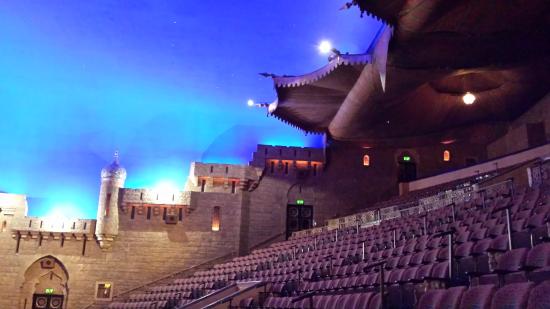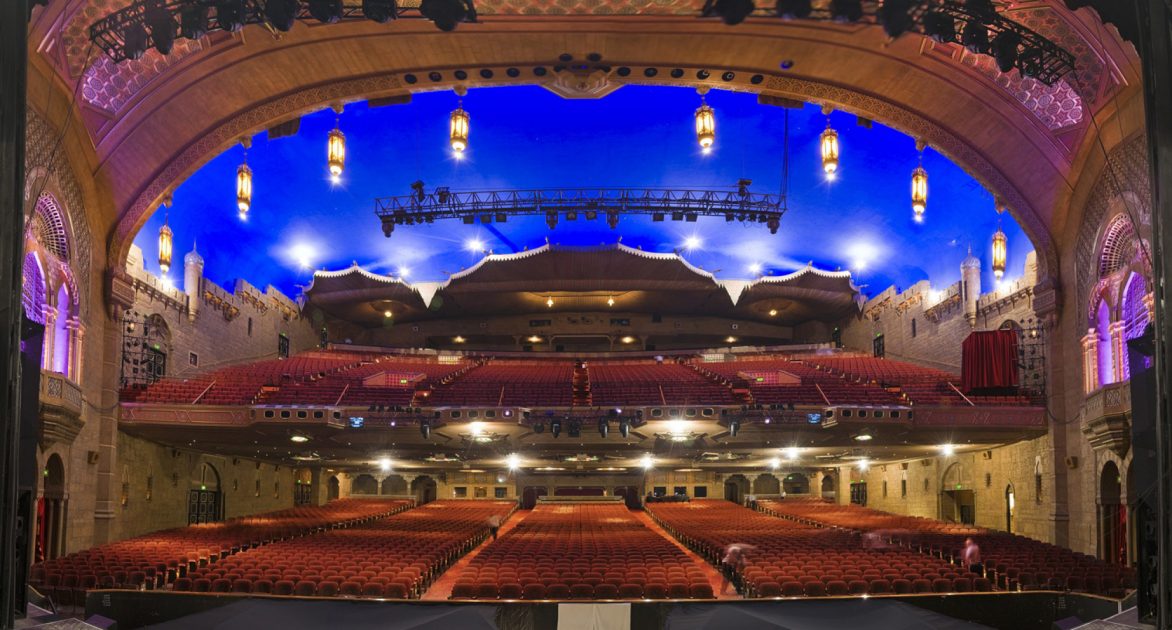The Fox Theatre is one of Atlanta’s premiere venues for live entertainment. The Fox’s 4,678 seat theatre hosts more than 150 performances like Broadway, rock, comedy and movies. In 2009, Billboard Magazine ranked the Fox Theatre in Atlanta as “The #1 non-residency venue worldwide for the decade.” In addition to our world famous theatre, the spectacular ballrooms have hosted everything from Sweet 16’s to weddings and corporate events.
The auditorium replicates an Arabian courtyard complete with a night sky of 96 embedded crystal “stars” , 1/3 flicker, and a projection of clouds that slowly drift across the “sky.” A longstanding rumor that one of the stars was a piece of a Coca-Cola bottle was confirmed in June 2010 when two members of the theater’s restoration staff conducted a search from within the attic above the auditorium ceiling.
The Egyptian Ballroom is designed after a temple for Ramses II at Karnak while the mezzanine Ladies Lounge features a replica of the throne chair of King Tut and makeup tables that feature tiny Sphinxes. The Islamic sections feature a number of ablution fountains, which are currently kept dry. Throughout the Fox there is extensive use of trompe l’oeil; “wooden” beams are actually plaster, paint that appears gold leaf is not, areas are painted and lit to appear to receive outside lighting, ornate fireplaces were never designed to have working chimneys, and what appears to be a giant Bedouin canopy in the auditorium is plaster and steel rods designed to help funnel sound to the farthest balcony.


The box office, which faces
directly onto the sidewalk, is at the front of an
arcade that is quite deep.
One time longlonglong ago, my buddy and i were wandering around at 2AM on our bicycles.
I have no idea, at this remove, why.
Anyway, we began racing our bikes the length of the arcade and back, nearly sliding out and crashing into the doors on the tile at the back, and looping out onto the sidewalk around the box office.
A police car came along - we didn't notice.
The officers apparently watched us make two or three circuits.
Then they came over and suggested that, perhaps there was somewhere else we could race?
One time longlonglong ago, my buddy and i were wandering around at 2AM on our bicycles.
I have no idea, at this remove, why.
Anyway, we began racing our bikes the length of the arcade and back, nearly sliding out and crashing into the doors on the tile at the back, and looping out onto the sidewalk around the box office.
A police car came along - we didn't notice.
The officers apparently watched us make two or three circuits.
Then they came over and suggested that, perhaps there was somewhere else we could race?

View from an upper-story
apartment on Ponce de Leon Avenue across Peachtree
Street


In Jim Crow Days,
the "colored" entrance was here (on the Ponce de Leon
Avenue side) - probably the small door at the very
top, leading to the highest balcony.



The proscenium arch is styled
to look like a bridge between buildings; the entire
interior is styled to look like a Moorish town.

To the right--->
What makes The Mighty Mo, The Fox Theatre’s organ, so special
The Mighty Mo, a 3,622-pipe organ custom made for The Fox by M.P. Möller in 1929, is the second-largest theater organ in the world - bested only by the Wurlitzer organ at Radio City Music Hall in New York City. The fact that it’s still here is largely thanks to Joe Patten, the so-called “Phantom of The Fox,” who passed away in August 2016 at 89.
By the 1960s, The Mighty Mo was falling apart, along with much of The Fox. Patten, who repaired organs as a hobby, spent months restoring it, and eventually became a fierce preservation advocate for The Fox and the theater’s technical director. Since then, The Mighty Mo has been in pristine, wall-shuddering condition.
What makes The Mighty Mo, The Fox Theatre’s organ, so special
The Mighty Mo, a 3,622-pipe organ custom made for The Fox by M.P. Möller in 1929, is the second-largest theater organ in the world - bested only by the Wurlitzer organ at Radio City Music Hall in New York City. The fact that it’s still here is largely thanks to Joe Patten, the so-called “Phantom of The Fox,” who passed away in August 2016 at 89.
By the 1960s, The Mighty Mo was falling apart, along with much of The Fox. Patten, who repaired organs as a hobby, spent months restoring it, and eventually became a fierce preservation advocate for The Fox and the theater’s technical director. Since then, The Mighty Mo has been in pristine, wall-shuddering condition.

The console rises into view from
a pit. The tab stops are different colours, and they
light up.
Since it was intended to be played to accompany silent films, it has sound effects - one of which is a "Crash" - a drum half filled with scrap metal. For the "Crash" effect, it briskly rotates a quarter or a half turn. For the "Grand Crash", it continues rotating until the organist stops it.
An exhaustive page about the organ can be found here.
Since it was intended to be played to accompany silent films, it has sound effects - one of which is a "Crash" - a drum half filled with scrap metal. For the "Crash" effect, it briskly rotates a quarter or a half turn. For the "Grand Crash", it continues rotating until the organist stops it.
An exhaustive page about the organ can be found here.

